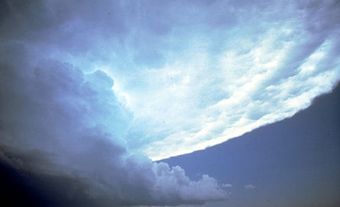Jet Stream
The jet stream is a band of WIND moving high above the Earth's surface from west to east. Typically, the jet stream circles the Earth between 8-14 km above the ground. It is 2-4 km deep, 50-150 km wide and a few thousand kilometres long. Speeds occasionally reach 400 km/h but on the average blow over North America at l00-200 km/h, circling the globe in about 5 days. Usually several jet stream systems travel around the Earth, sometimes in a discontinuous band, other times completely encircling the globe. Now and then they branch into 2 or 3 streams, only to merge as a stronger jet stream downwind.
There are 2 major jet streams in the Northern Hemisphere. The subtropical jet stream is located near 25° N latitude during the Northern Hemisphere winter; it is generally less energetic and less variable than its northern counterpart and consequently has little direct effect on weather. The polar jet stream is located at the boundary between cold air to the north and warm air to the south. In summer, the average location of the polar jet stream over central Canada is about 50° N latitude. In winter, it arcs northward over BC, forms a ridge over the province then turns sharply southward over the Great Plains. It then plunges as far south as northern Texas before curving northeastward over the Mississippi River valley. Finally, it wends its way eastward and leaves North America over New England or Atlantic Canada.
At times the jet stream follows the lines of latitude, driving mild, moist air from the Pacific Ocean all the way across Canada, generally causing moderate and changeable weather. Other times the jet stream resembles a rollercoaster, looping far north then plunging south, spreading frigid Arctic air into the central portion of North America and mild air from the Gulf of Mexico to the eastern seaboard.
The jet stream exerts a considerable influence on weather. It moves masses of air in and out of Canada, strengthens storms and steers low and high pressure centres. As a general rule, when the jet stream is to the south cold air pushes southwards, and when the jet stream is to the north weather comes from the west or south

 Share on Facebook
Share on Facebook Share on X
Share on X Share by Email
Share by Email Share on Google Classroom
Share on Google Classroom


